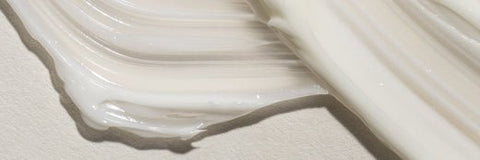We all want that airbrushed, photo finish. But maintaining it with unwavering consistency is a bit unrealistic. Not even supermodels have smooth, even skin all the time. Keep reading as we discuss what causes uneven tone and how to fix it.
IN A NUTSHELL
Main Takeaways: Uneven skin tone can strike at any age; while some of its causes require the help of a medical professional, many cases can be prevented and easily managed with a proper skincare routine.
Good to Know: Sun exposure is the most common reason for uneven skin tone, so don’t leave the house without wearing sunscreen!
Recommended Products: Crème de la Cream Brightening Moisturizer, ‘A’ Game Retinol Serum, and Nectar of the C Vitamin C Serum.
What Is Uneven Skin?
Uneven skin tone is a common occurrence that can be experienced at any age. The term refers to a change in pigment and can be seen as either lightness, darkness, or redness. It happens for a number of reasons, most of which are not threatening; but even the most minor tonal issues can feel bothersome at times. Knowing how to best prevent or correct them begins with understanding their cause.
Common Causes of Uneven Skin Tone
Hyperpigmentation
Most cases of uneven skin tone are due to hyperpigmentation, which is an overproduction of melanin in the skin. This can occur for a few of reasons:
- Sun Exposure - Harmful UV rays can lead to discoloration when the skin produces excess melanin to prevent damage. This results in flat, often ovular, black or brown patches that go by a variety of names, including sun spots, liver spots, or age spots. But don’t be fooled– while these marks do develop over time, they can appear no matter what your age. Excessive sun exposure can also darken your freckles, cause temporary burns, and lead to more serious, tone-altering conditions.
- Post-Inflammatory Hyperpigmentation - This occurs after the healing of a skin wound. As the skin regenerates, it produces excess melanin, resulting in dark, flat spots that can show in a spectrum of colors - brown, red, gray, black, pink, or purple. Post-inflammatory hyperpigmentation can occur after any sort of skin injury but is most often the result of acne scars or a post-picked-at blemish. Post-inflammatory hyperpigmentation is usually permanent; but with dedicated care, the associated skin discolorations can fade over time.
- Melasma - This is a skin condition caused by an increase in hormone stimulation. It is marked by an irregular darkening of the skin, occurring usually on the face. Melasma is sometimes referred to as “pregnancy mask,” as it is most commonly experienced by pregnant women; only ten percent of melasma cases occur in men. However, melasma can also be the result of other hormone-altering events, like the use of certain contraceptives, or the introduction of other products or medications. Melasma is harmless and largely temporary, as the associated changes in pigment often fade in conjunction with the regulation of hormones.
- Environmental Stressors - Ambient particles and gasses found in densely populated, urban areas can seep into pores. Over time, this can cause brown spots, particularly on areas most often exposed to the elements, like the face.
Vitiligo
Vitiligo can be understood as the opposite of hyperpigmentation. Rather than an overproduction of melanin, the same pigment-producing cells are inactive, leading to the emergence of light patches on the skin. While it can be the result of a variety of things, including autoimmune disease and genetics, vitiligo is exceedingly rare, affecting a total of only about 1% in individuals globally.
Rosacea
Rosacea is a chronic condition that brings about fiery, flushed tones on and around the face. It is extremely common, but its cause is unknown. Many doctors suspect it may be related to a number of factors like genetics, lifestyle, and elemental exposure. Rosacea is a medical condition, and its management requires the attention of a medical professional.
Lifestyle
Believe it or not, your daily choices can sometimes make all the difference in your skin’s pigment and tone. Smoking and alcohol consumption can have an immeasurable impact on your complexion, leading to an uneven appearance. These can cause surface irritation and dry skin, resulting in increased redness and inconsistent coloration.
Infection or Disease
There are times when changes in skin color or tone are more than just superficial. That is why every notable change in complexion, sudden or gradual, should be evaluated by a licensed dermatologist to ensure skin health.

How To Prevent Uneven Skin
While some tonal conditions undoubtedly require the help of a medical professional, there are a number of things you can do to limit your likelihood of developing uneven skin.
- Wear Sunscreen. Most pigment issues are a result of the sun’s harmful UV rays. Limiting sun exposure and wearing a broad-spectrum SPF can largely protect you and your face from skin discoloration.
- Stop Touching Your Face. Acne scars are a major cause of premature changes in tone. When keeping your paws off, you limit the chance of inducing skin trauma, which can help minimize the amount of irregularly produced melanin.
- Make Good Lifestyle Choices. Ditch the cigarettes, limit your alcohol consumption and enjoy a healthy, balanced diet, rich in color and nutrients. Exercise regularly. Use quality, naturalistic skin care products, free of nasties and irritants. And don’t forget to drink plenty of water to keep your skin hydrated from the inside out.
How to Fix Uneven Skin Tone
Luckily, there are a few simple steps you can incorporate into your routine to help minimize the appearance of uneven skin tone, many of which are basic tenets of proper skincare.
Exfoliate
Exfoliating sloughs off dead cells at the surface, revealing a smoother complexion and dramatically affecting how it appears.
Moisturize
Moisturizing fortifies skin with proper nutrients and remedies dryness that can cause redness and irritation. Use a face cream formulated specifically to even out skin tone, like Fleur & Bee’s Crème de la Cream brightening moisturizer.
Apply Vitamin C
Vitamin C serums are the answer to those dark spots you never saw coming, but some can be a bit harsh on the skin. Opt for a gentle formula like our Nectar of the C vitamin C serum. It employs sodium ascorbyl phosphate instead of pure vitamin C, so those with sensitive skin can use it twice a day and get all of the same amazing results.
Treat with Retinol
Retinol is known for its ability to increase cell turnover in skin. That means it rids of the dead, dull and potentially damaged skin at the surface and reveals newer, brighter skin. Incorporating ‘A’ Game retinol serum into your skincare routine will help you improve your skin tone, smoothing your skin in the process.
Note while vitamin C and retinol can complement each other, they should not be used on your skin at the same time. We recommend using a vitamin C serum during the day, as vitamin c also helps protect your skin against the sun. Apply retinol in the evening, allowing it to work its magic while you sleep.
While uneven skin tone can come from various sources, just remember that the sun will always make it worse. Sunscreen is always going to be your skin’s best friend.
When tonal changes show up on your face, don’t get mad– get even!







